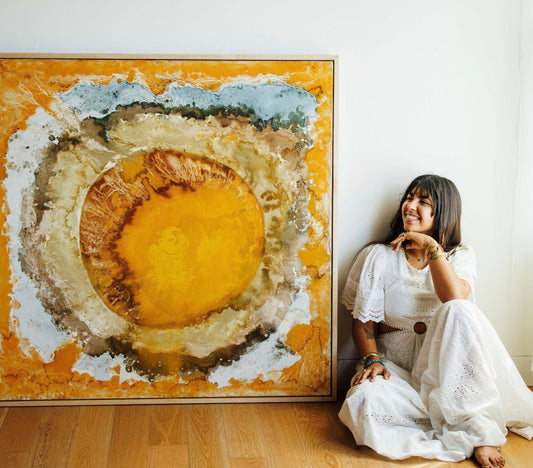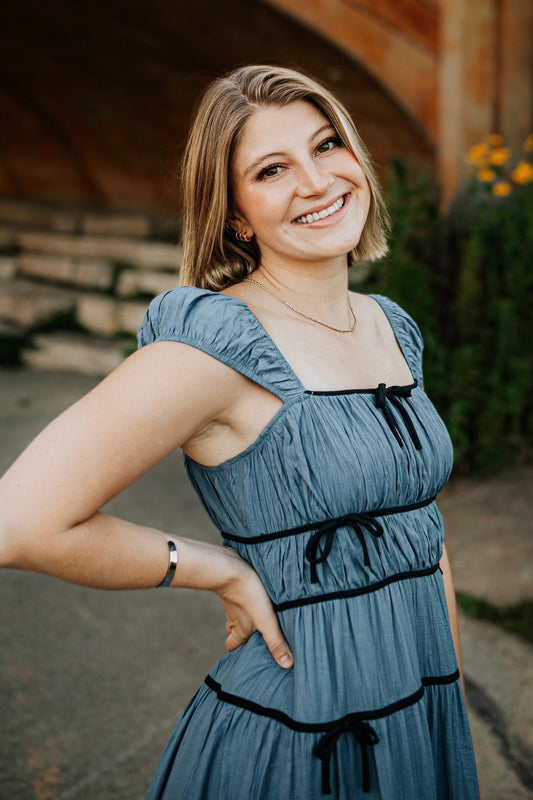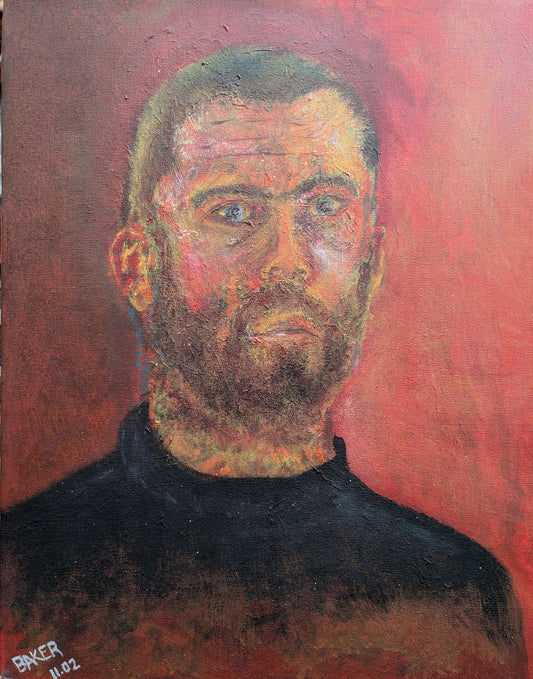Circular Compositions: Artist Linling Lu Explores Music, Color, Composition, and Light
Like a portal inviting you to another world, or a time machine ready to take you to a past life, or perhaps a meditation tool able to transport you into a realm of inner peace–Artist Linling Lu offers a melodic escape for viewers through abstract circular works.
Linling Lu is originally from Zunyi, Guizhou Province, China, and lives and works in Baltimore, Maryland. The artist’s website states that “her human-scale tondos have been described as inducing states of meditation. Lu’s work also includes sculptures of interlocking wood blocks, shaped paintings, and sewn fabric collages.” Earning a BFA and MFA in painting from the Maryland Institute College of Art, Linling’s art seamlessly blends academically informed technique, musical rhythms, meditative qualities, and abstract color expression.
The Kalamazoo Institute of Arts hosted Lu for a lecture, during which chief curator Rehema Barber stated throughout “the pandemic, Lu viewed her circular works as a means of healing from the chaos and uncertainty of life. Her large circular canvases pulsate with color and invite viewers to reflect on their own memories and connections with music.”Lu’s exhibition at the Kalamazoo Institute of Arts, titled Musical Meditations, explores her connections and reactions to sound and color.
Born in a mountainous area in southwestern China, Lu was inspired by her musically inclined parents to learn piano and experience Western classical music from afar. Lu’s father played classical music to her as a baby, and by the age of 4, she was playing a medium-sized electronic piano in group lessons. Lu practiced piano and Western music theory every day for 12 years.

From the start, music was an integral part of Lu’s life, but at the age of 16, her demanding school schedule pulled her away from the piano, sparking a newfound curiosity in drawing and painting. According to the Kalamazoo Institute of Arts, Lu realized at this moment she “had to become an artist, and to live a life with art and music.”
Through her studies, Lu learned of music’s influence in Georgia O’Keefe’s paintings and Wassily Kandsinky’s art. During her lecture, Lu recounted, “With sparks from Kandsinky’s writing, and my own experience in music, I wrote an essay titled ‘Music in Georgia O'Keeffe's Painting,’ which discussed how O’keefe’s paintings can be read as pure music.”
Lu began to apply her musical experience to her art and has continued to explore this connection ever since. For Lu, color and sound are connected–and the exploration seems limitless.
In 2009, Lu began working with round-shaped canvases. These efforts eventually became a project called 100 Melodies of Solitude. Lu imagined each canvas as “abstract instruments with their own sounds and music.” Lu continued to compose these abstract circular instruments, meticulously combining them to form choruses of complementary voice parts.
For Lu, the circles contain melodies, beats, and sounds, and the capabilities of the installation depend on the space, composition, and tonal qualities of each circle. Lu states, “Compositional installation was invented as a way to create a symphony effect.” This effect is precisely what she accomplishes through each new installation.
As a vocalist with experience performing in a variety of acapella groups and choruses, I resonate with Lu’s installations as melodic ensembles. Each circle embodies a distinct sound and vocal part, harmoniously merging together to create a cohesive body of work. Vowel shapes, breath control, the acoustics of a space, and the positioning of people in a singing group all contribute to the final result. It is fascinating to see how Lu’s circles must also consider these musical elements, even though the circles exist in a 2-dimensional, visual form. After recognizing the musical influence present in these circles, it becomes an unchangeable part of the viewer’s perception—it cannot be unheard.
While individual sounds are important to her circular works, the composition, and overall musical movement is also crucial in constructing the curatorial layout. In thinking about the flow of a composition with a beginning, middle, and end, Lu relies on music to guide her installations, finding balance and harmony in unison. Sometimes, she even listens to a song while determining the flow of her carefully composed melodies.

Lu continues to explore music, composition, sound, shape, and curation in her more recent artworks. This past spring, Soundwaves, an installation at The Phillips Collection, demonstrated the intersectionality of music, movement, and Lu’s abstract choral concepts. The Phillips Collection website states, “Soundwaves responds to Philip Glass’s Etude no. 16 played on piano by Timo Andres as part of the 2015 Phillips Music program. Lu’s paintings visualize the sound in a spatial configuration—soundwaves. Repetitive notes and chords from Glass’s music are translated into a physical space: the seven notes played on the piano by the left hand are represented by seven paintings on the left side of the gallery and the five notes played by the right hand are represented by five paintings on the right side of the gallery.”
Our very own ArtRKL team had the chance to witness Lu’s work in-person at the Seattle Art Fair. They remarked that “Linling’s work in person is all-encompassing and showing stopping. There is absolutely no chance one can walk by without being intrigued. The vibrant colors matched with blocking and fading on a circular canvas is like looking into the future!”
And then we had the chance to ask Linling the questions we’ve been wondering:

Q: You mentioned how the piano influenced you since you were young. Is there a song, piece, or genre that still really inspires you/remains influential to you today?
A: I was trained as a classical pianist for about 12 years since age 4. One of the most played/listened pieces is Waltz Op.64 No.2 by Chopin. I also love Bach’s work and find both Bach and Chopin not only help enabling the technical connections between art and music, but also guide me through the creation process and artistic life at large - making paintings is to create transcendent musical experiences.
Q: If your circles turned into an instrument, which instrument do you think they would become? Or, to keep it broad, what sound would they make?
A: Round pianos (Ha!)…color bands are like strings, mixing and adjusting colors has become an instrument tuning process.
Q: How do you approach the selection of color in your work? Do you consider colors as they relate to sound? With some colors ‘sounding’ more minor and some colors seeming more “major?”
A: The colors and color relationships of my work come form long time observation of nature and practice of sounds. I create digital studies to explore various possibilities. A color group (chord) can be “minor” or “major” but the choice can be subjective and personal.
Q: Are there any new themes influenced by sound or music you are considering exploring in the future?
A: Yes. Variation Series. Started in 2020, Variation is a new painting series that continues exploration of Color, Shape and Musical Imaginations. As a child of One Hundred Melodies of Solitude and shaped textile works, Variation Series exercise colors and their relationships in varied shaped forms.
It is possible that as a music lover and musician, I was subconsciously attracted to the underlying musical expression influencing Linling’s designs. And, after this immediate pull toward her work, I was thrilled to ask some questions as someone fascinated by music’s influence on color & design. Follow Linling Lu’s incredible melodic exploration through Instagram and website as she continues to follow her musical and artistic calling.
©ArtRKL™️ LLC 2021-2023. All rights reserved. This material may not be published, broadcast, rewritten or redistributed. ArtRKL™️ and its underscore design indicate trademarks of ArtRKL™️ LLC and its subsidiaries.







